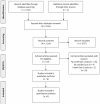Best practice elements of multilevel suicide prevention strategies: a review of systematic reviews
- PMID: 21945840
- PMCID: PMC3306243
- DOI: 10.1027/0227-5910/a000109
Best practice elements of multilevel suicide prevention strategies: a review of systematic reviews
Abstract
Background: Evidence-based best practices for incorporation into an optimal multilevel intervention for suicide prevention should be identifiable in the literature.
Aims: To identify effective interventions for the prevention of suicidal behavior.
Methods: Review of systematic reviews found in the Pubmed, Cochrane, and DARE databases. Steps include risk-of-bias assessment, data extraction, summarization of best practices, and identification of synergistic potentials of such practices in multilevel approaches.
Results: Six relevant systematic reviews were found. Best practices identified as effective were as follows: training general practitioners (GPs) to recognize and treat depression and suicidality, improving accessibility of care for at-risk people, and restricting access to means of suicide. Although no outcomes were reported for multilevel interventions or for synergistic effects of multiple interventions applied together, indirect support was found for possible synergies in particular combinations of interventions within multilevel strategies.
Conclusions: A number of evidence-based best practices for the prevention of suicide and suicide attempts were identified. Research is needed on the nature and extent of potential synergistic effects of various preventive activities within multilevel interventions.
References
-
- Adli M., Bauer M., & Rush A. J. (2006). Algorithms and collaborative-care systems for depression: Are they effective and why? A systematic review. Biological Psychiatry, 59, 1029–1038. - PubMed
-
- Althaus D., & Hegerl U. (2003). The evaluation of suicide prevention activities: State of the art. The World Journal of Biological Psychiatry, 4, 156–165. - PubMed
-
- Al Windi A. (2005). Depression in general practice. Nordic Journal of Psychiatry, 59, 272–277. - PubMed
-
- Bernal M., Haro J. M., Bernert S., Brugha T., de Graaf R., Bruffaerts R., ... the ESEMED/MHEDEA investigators. (2007). Risk factors for suicidality in Europe: Results from the ESEMED study. Journal of Affective Disorders, 101(1-3), 27–34. - PubMed
-
- Bool M., Blekman J., de Jong S., Ruiter M., & Voordouw I. (2007). Reduction of suicidality. Utrecht, Netherlands: Trimbos-Instituut.
Publication types
MeSH terms
Grants and funding
LinkOut - more resources
Full Text Sources
Medical


